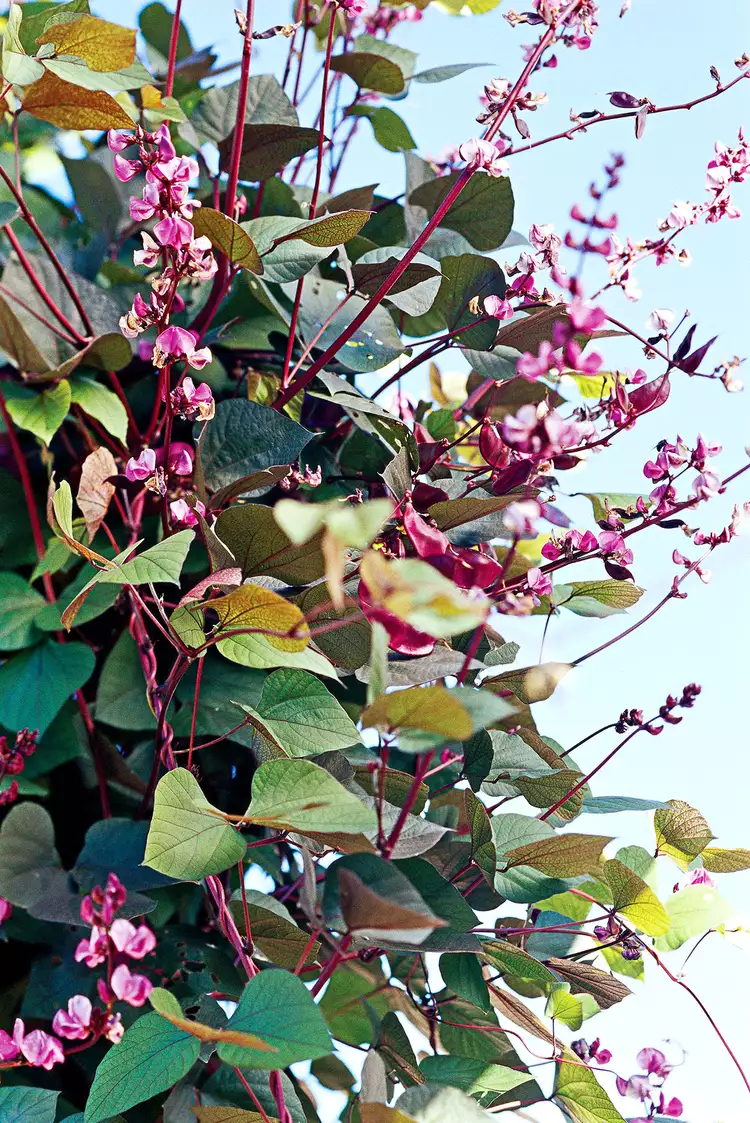Purple hyacinth bean vines have long graced gardens around the world with their lush foliage, abundance of purple flowers, and shiny purple pods. Native to Africa, these vigorous flowering vines will climb just about any available support they can twine around. In addition to their beauty, hyacinth bean's easy-care nature, ability to add nitrogen to the soil, and edible leaves and shoots make these plants deserving of a place in your garden.
Purple Hyacinth Bean Vine Overview
| Genus Name | Lablab purpureus, Synonym: Dolichos lablab |
| Common Name | Purple Hyacinth Bean Vine |
| Additional Common Names | Hyacinth Bean, Lablab |
| Plant Type | Vine |
| Light | Sun |
| Height | 15 to 20 feet |
| Width | 6 to 10 feet |
| Flower Color | Pink, Purple |
| Foliage Color | Blue/Green |
| Zones | 10, 11 |
| Propagation | Seed |
Where to Plant Hyacinth Bean Vine
Purple hyacinth bean vines can get very big. Choose a location in your garden where these plants can grow without shading out other plants or needing to be pruned back all the time. Some varieties can attain heights of about 20 feet, so plenty of room to twine up a trellis, fencing, or other structures is a must. An ideal location will also provide plants with good air circulation and be away from heat sinks such as hot walls or fences in warmer climates.
How and When to Plant Hyacinth Bean Vine
Hyacinth beans vines prefer cooler weather, but unlike many other beans and peas, these plants will not tolerate temperatures dipping below freezing. Start seeds indoors 2-3 weeks prior to the expected last frost in spring, then transplant into the garden after the danger of frost has passed.
Hyacinth Bean Vine Care Tips
Light
Like most fruits and vegetables, hyacinth beans require full sun for best flower and pod production. While they can handle some shade, they’ll produce far less in shady conditions.
Soil and Water
Hyacinth beans get big, and with their size comes a need for rich soil and ample moisture throughout the growing season. Loamy, well drained soils with plenty of organic matter are ideal, although hyacinth beans can survive in many types of soil, provided there is consistent moisture.
Temperature and Humidity
Like many beans and peas, hyacinth beans prefer cool to warm temperatures and low to high humidity. However, excessive heat and low humidity can stymie growth. In locations with higher humidity, provide good air circulation around vines to limit diseases.
Fertilizer
As part of the bean family (Fabaceae), hyacinth beans do produce their own nitrogen with help from bacteria contained in little nodules on their roots. However, because of their fast growth and large size, your plants will benefit from feeding a “bloom booster” fertilizer that is low in nitrogen and high in phosphorus every 2-3 weeks.
Pruning
Aside from some light trimming of your thriving vines, very little pruning is necessary. Flowers should be left on the vine for their ornamental (albeit mostly inedible) purple pods. In regions with warm weather throughout the end of the growing season, healthy vines can be pruned back toward the end of the season and new growth will replace old, eventually bloom, and produce more pods.
Pests and Problems
Due to their large size, fast growth, and overall vigor, hyacinth beans are rarely bothered by major pest infestations or diseases. However, just like all other plants, there are a few issues to look out for when they occur.
The native long-tailed skipper butterfly will use purple hyacinth bean vine (and its relatives) as a host plant. The small, green caterpillars rarely damage the large vines of hyacinth beans, however, and can be left to complete their life cycles.
Especially in areas with high humidity and low air circulation, fungal diseases can pop up, though rarely across the entirety of the vine. To mitigate outbreaks, increase airflow around your vines by trimming back nearby plants if possible, or thinning your hyacinth bean vines. Organic fungicides such as copper and neem oil can help control cases of severe infection.
How to Propagate Purple Hyacinth Bean
Hyacinth bean vines can easily be propagated by seed, which can be found in most places where fruit and vegetable seeds are sold. To start your seeds indoors, follow these simple steps:
- Soak your hyacinth bean vine seeds overnight in water.
- Prepare seed-starting containers or trays with a seed-starter mix
- Plant pre-soaked seeds about a half inch deep in the potting mix.
- Moisten soil and keep containers in a warm, bright location. Seedlings should begin to appear within a week of planting, but may take upwards of two weeks.
- Transplant into garden or outdoor containers after the third set of leaves have appeared and seedlings have been hardened off.
Alternatively, seeds can be directly sown outdoors in Hardiness Zones 10 and above, or after temperatures have begun to rise into the 50s and the risk of frost has passed.
Types of Purple Hyacinth Bean
There are a few varieties of hyacinth bean vines to choose from.
White Hyacinth Bean
Encompassing white varieties such as ‘Silver Moon’ and 'Alba', white-flowered hyacinth beans grow just like the standard purple hyacinth bean vines but also bear green pods, and green stems, lacking all traces of purple.
'Ruby Moon' Hyacinth Bean
Very similar to the straight species, 'Ruby Moon’ blooms for a longer period during the growing season.
Companion Plants
Due to their huge size, hyacinth bean vines are typically grown alone, but can be intermixed with other large, vigorous plants. For example, a few vining annuals such as moonflower vine (Ipomoea alba) and black-eyed Susan vine (Thunbergia alata) can hold their own with a hyacinth bean.




















